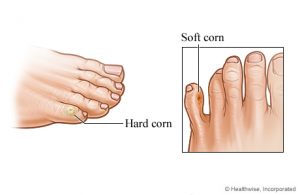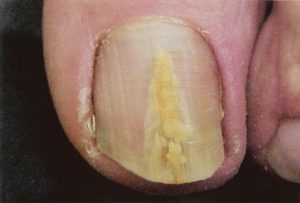Feet. Often overlooked and under-appreciated, feet are vital to our mobility, our quality of life, and even our survival. Comprised of 26 bones, 2 sesamoid bones, 33 joints, 19 muscles and 107 ligaments, each, feet have been referred to as a perfect marriage of form and function, exquisite engineering designed to propel, pivot and take us where we want to go.
The skin on our feet may look quite ordinary, but in reality is a complex marvel of fat pads, pores and blood vessels, all working to ensure every step we take is balanced and evenly pressured. The tightly-stretched sole of the foot contains the thickest skin of the human body is criss-crossed by a set of creases that react to pressure from walking and standing, and includes as many as 200,000 extremely sensitive nerve endings, which explains why it can hurt to step on a pebble, or why feet can be ticklish!
Toenails, nature’s great protectors, are intricate wonders, incorporating multipole layers of protein-rich tissue, a growth-promoting matrix, and several delicate membranes designed to protect against and prevent bacterial invasion and infection. Function to protect the ens of our toes from injury, toenails enhance the delicate sensation exerted on our toes when we walk or stand. Toenails grow slowly, approximately 1mm per month.
Feet speak a very special language – one of pressure, friction and shear forces, as well as environmental factors, to which they respond in a number of specific ways.
 Calluses, a common response to repeated pressure on particular areas on the foot, are made up of tough skin cells, and appear in many different shapes and sizes. Generally not harmful on their own, regular attention to calluses helps minimize their growth, and keeps them from becoming painful, or leading to other problems such as skin ulceration or infection. Gentle, occasional use of a pumice stone lubricated with some soap, on calluses, together with daily application of a urea-based foot cream can make a significant difference in their size
Calluses, a common response to repeated pressure on particular areas on the foot, are made up of tough skin cells, and appear in many different shapes and sizes. Generally not harmful on their own, regular attention to calluses helps minimize their growth, and keeps them from becoming painful, or leading to other problems such as skin ulceration or infection. Gentle, occasional use of a pumice stone lubricated with some soap, on calluses, together with daily application of a urea-based foot cream can make a significant difference in their size
Corns are usually round, and form on thin, smooth surfaces of feet. Funnel-shaped, with the wider area on the skin surface, and the point down in the tissue, corns can be irritating and painful. Reducing the pressure at the corn’s location with
skin surface, and the point down in the tissue, corns can be irritating and painful. Reducing the pressure at the corn’s location with
specially designed toe separators, or applying a corn pad, will help to minimize the pain and continued growth of the corn.
Athlete’s foot, a fungal infection, usually appears as patchy, peeling, itchy skin on the sole and between toes. Sparing application of medicated foot powder will help reduce itching and progression of this condition. When skin between toes looks white, thicker and cracked, it’s time to seek medical attention. Treatment with a prescription anti-fungal cream will help; untreated athlete’s foot can lead to toenail fungus. Fungus adores a warm, dark, moist environment; keep those feet dry!
Ingrown toenails occur several ways; a sliver of nail pierces the skin, or the skin grows over the nail. Either way, it’s painful! Poorly fitting or too-tight foot-wear, cutting into the skin at the edge of the nail, or picking at the nail can all produce ingrowing nails. Infection can occur if the area isn’t kept clean. Conservative management includes short, warm salt-water soaks, gentle drying, and application of antibacterial ointment. Never dig or cut into the nail or skin around it. If the toenail’s deeply ingrown, surgical treatment may be necessary.
Toenail fungus (aka onychomycosis – ‘on-E-co-my-co-sis’) affects up to 50% of the population greater than 70 years of age, and up to one third of people with diabetes. Mistakenly considered a purely cosmetic concern, unchecked fungal infection relentlessly pushes on until the nail plate is destroyed, and can trigger additional infectious lesions in the body. Fungus  generally thickened, yellows and crumbles the toenail; it can start as a yellow ‘blob’ on the nail. Treatment options include daily application of topical anti-fungal, photodynamic therapy, or oral tablets, which require fastidious medical monitoring of liver function. Tea tree oil has been shown to have anti-fungal properties, and sparing application to toenails may help reduce the infection. Be wary of any treatments suggesting application of vinegar or acids. A discussion with your doctor will help diagnose and provide treatment for this condition. Topical treatment requires diligence and persistence -sometimes up to a year of daily treatment, and is less expensive than photodynamic therapy, a newer, shorter treatment option. In a word, persevere!
generally thickened, yellows and crumbles the toenail; it can start as a yellow ‘blob’ on the nail. Treatment options include daily application of topical anti-fungal, photodynamic therapy, or oral tablets, which require fastidious medical monitoring of liver function. Tea tree oil has been shown to have anti-fungal properties, and sparing application to toenails may help reduce the infection. Be wary of any treatments suggesting application of vinegar or acids. A discussion with your doctor will help diagnose and provide treatment for this condition. Topical treatment requires diligence and persistence -sometimes up to a year of daily treatment, and is less expensive than photodynamic therapy, a newer, shorter treatment option. In a word, persevere!
Gentle, regular care of your feet is important; never, ever use a blade or workshop tool on your feet! Feet are precious and not to be taken for granted. An average person will walk approximately 178,000 km in a lifetime – almost five times around the earth at the equator. Love your feet and they’ll love you back.
